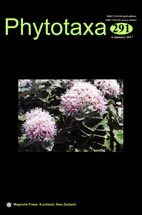Abstract
Climacodon comprises species characterized by a hydnoid hymenophore, a monomitic hyphal system and spores without iodine reactions. Climacodon pulcherrimus is unique within Climacodon due to having multiple clamp connections. Current taxonomy of Climacodon relies exclusively on treatments based on morphological observations. In this study, we constructed a 6-locus DNA phylogeny (LSU, 5.8S, SSU, RPB2, ef-1α, RPB1) to evaluate the monophily of Climacodon. Our results show that Climacodon is polyphyletic as currently circumscribed. Climacodon sanguineus forms a well-supported clade with C. septentrionale, type species of Climacodon, and nests in the Phlebioid clade. A third species, Climacodon roseomaculatus, is closely related to C. sanguineus based on ITS sequence data. Hence, these three species belong to Climacodon s. str., which is characterized by having thick-walled crystalliferous cystidia. Meruliaceae is adopted as family placement for Climacodon s. str. and the whole Phlebioid clade. On the contrary, Climacodon pulcherrimus is nested in the Phanerochaete clade and better accommodated in the monotypic genus Donkia, within Phanerochaetaceae. The presence of multiple clamps by septum in C. pulcherrimus is shared with some Phanerochaete species of this clade. Recent collections of C. sanguineus were compared with the type material, and coloured photographs of macro- and microscopic features of C. sanguineus and Donkia pulcherrima are provided.

